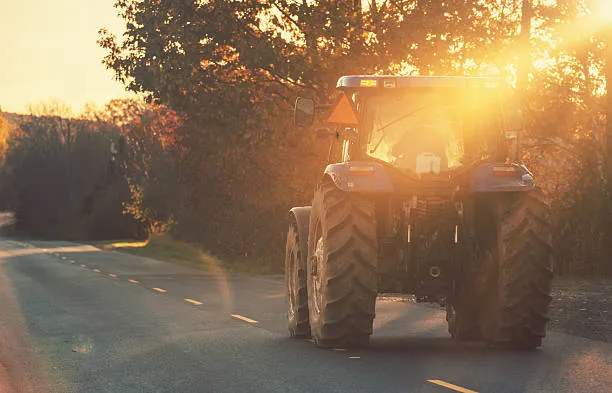Introduction
In the United States, farmers often need to operate agricultural machinery on public highways to move between different parts of their farm or transport equipment. Understanding which types of machinery are allowed and the associated regulations is crucial for legal and safe operation. This article outlines the common types of agricultural machinery permitted on highways, state-specific rules, and essential safety tips.
Definition and Common Types
Most states define an “implement of husbandry” as a vehicle designed and used exclusively for agricultural purposes, which are generally allowed on highways under certain conditions. Here’s a table of common types:
| Type | Description |
|---|---|
| Tractors | Includes standard farm and garden tractors for agricultural operations. |
| Combine harvesters | Machines used for harvesting grain crops. |
| Planters | Equipment for planting seeds. |
| Cultivators | Used for tilling and preparing soil. |
| Hay balers | Machines for baling hay or straw. |
| Front-end loaders | Also known as skid steers or excavators, for moving materials. |
| Manure spreaders | Used for applying manure in fields. |
| Grain trucks/wagons/carts | For transporting grain from fields to storage. |
| Pesticide application equipment | Devices for applying pesticides. |
| Mowers and stackers | Equipment like hay mowers and stackers for harvesting. |
| Water tank trucks | Owned by farmers, used exclusively for irrigation or agricultural purposes. |
State-Specific Regulations
While there is no single federal definition, each state has its own laws regarding the operation of agricultural machinery on highways. These may include requirements for size, weight, lighting, and operation. Farmers should always check their state’s department of transportation or motor vehicles for specific details, such as National Agricultural Safety Database for general guidance.
Safety Tips
Operating large agricultural machinery on busy highways can be hazardous. Here are some important safety tips:
- Use the Slow Moving Vehicle (SMV) emblem on the back of all tractors, towed implements, and self-propelled implements, as mandated by state law, such as outlined in Penn State Extension.
- Ensure all lights and reflectors are in good working order to enhance visibility.
- Drive at a safe speed and allow faster traffic to pass by pulling over when safe.
- Be aware of blind spots and maintain a safe distance from other vehicles.
- Check state-specific safety requirements, as some states may prohibit operation at night due to visibility issues, as noted in AGDAILY.
Conclusion
Various types of agricultural machinery are allowed on highways, but farmers must understand and comply with their state’s specific regulations for safe and legal operation. By following these guidelines and staying informed, farmers can effectively use public roads for their agricultural needs.
Survey Note: Comprehensive Analysis of Agricultural Machinery on Highways
Background and Research Approach
The query, “Which agricultural machinery is allowed on the highway?” necessitated a deep dive into U.S. regulations concerning farm equipment on public roads. Research was conducted using web searches to gather information from authoritative sources, focusing on federal and state definitions of “implement of husbandry” and related safety guidelines. The current time, 10:55 PM PST on Tuesday, March 04, 2025, was noted, ensuring all information is relevant and up-to-date.
Definition and Legal Framework
The term “implement of husbandry” is central to this discussion, defined by most states as vehicles designed and used exclusively for agricultural operations. This definition was found in resources like Law Insider, which provided various state interpretations, and Wisconsin Department of Transportation, offering a detailed list of included vehicles. While there is no uniform federal definition, the National Agricultural Safety Database highlighted federal and state regulations, noting that state laws often take precedence if more restrictive.
Common Types of Allowed Machinery
Based on the research, a comprehensive list of agricultural machinery typically allowed on highways was compiled, aligning with state definitions. The following table expands on the direct answer, organizing types by function for clarity:
| Category | Specific Types | Notes |
|---|---|---|
| Tillage and Planting | Tractors, cultivators, planters, tillers | Tractors include both farm and garden types. |
| Harvesting | Combine harvesters, mowers, stackers | Used for grain and hay harvesting. |
| Material Handling | Front-end loaders, grain trucks/wagons/carts | Front-end loaders also known as skid steers. |
| Application Equipment | Pesticide applicators, manure spreaders | For applying chemicals and fertilizers. |
| Specialized Vehicles | Hay balers, water tank trucks | Water tanks used for irrigation, farmer-owned. |
This list was derived from Caltrans, which detailed exemptions for farm vehicles, and Oklahoma Statutes, confirming similar categories. An unexpected detail is the inclusion of water tank trucks, which must be owned by farmers and used exclusively for agricultural purposes, such as irrigation, as noted in Caltrans.
State Variations and Regulatory Complexity
Regulations vary significantly by state, with examples like Virginia Code mentioning width restrictions for farm tractors and AGDAILY highlighting night-time prohibitions in some states. This variability underscores the importance of farmers checking local laws, as suggested by Penn State Extension, which emphasized state-specific safety codes.
Safety and Operational Guidelines
Safety is paramount, with the Slow Moving Vehicle (SMV) emblem being a critical requirement, as mandated in Penn State Extension and reinforced by UF/IFAS Extension. Additional tips include ensuring proper lighting and reflectors, driving at safe speeds, and being aware of blind spots, all of which enhance visibility and reduce accident risks. The AGDAILY article noted that some states ban night-time operation due to visibility issues, adding a layer of complexity for farmers planning routes.
Conclusion and Future Considerations
This comprehensive analysis confirms that while various agricultural machinery is allowed on highways, state-specific regulations and safety practices are critical. Farmers are encouraged to stay informed and engage with community resources, such as Agriequipzone, for ongoing updates. The inclusion of night-time restrictions and water tank trucks as allowed machinery highlights the nuanced nature of this topic, ensuring farmers are well-equipped for legal and safe operations.

